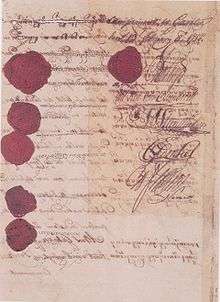Treaty of Giyanti

The Treaty of Giyanti (also known as the Treaty of Gianti Java, the Gianti Agreement, or the Giyanti Treaty) was signed and ratified on February 13, 1755 in Giyanti (southeast of Karanganyar, Central Java) between Prince Mangkubumi, the Dutch East India Company, and Sunan Pakubuwono III along with his allies. Based on the terms of the agreement, the eastern half of the Sultanate of Mataram in central Java was given to Pakubuwono III with Surakarta as its capital, while the western half was given to Prince Mangkubumi with its capital in Yogyakarta. This treaty marked the division of former territory of Mataram Sultanate between Surakarta Sunanate and Yogyakarta Sultanate.
After the signing of the treaty, Prince Mangkubumi changed his title as prince and became known as Sultan Hamengkubuwono I. The accord did not end hostilities in the area since Prince Sambernyawa (or Raden Mas Said) continued to fight against Pakubuwono III. The background of this treaty is perpetuated in a babad entitled Babad Giyanti.[1][2]
See also
References
- ↑ Brown, p. 63. On February 13, 1755, the Treaty of Giyanti was signed, dividing what was left of the kingdom of Mataram into two parts. One part, with its capital in the city of Solo, was headed by Pakubuwana II's son, Pakubuwana III. The other part, with its capital 60 kilometres to the west of Yogyakarta, was ruled by Pakubuwana II's half-brother Mangkubumi, who took the title Sultan Hamengkubuwono I. The treaty was not immediately accepted by all parties to the dispute: fighting went on for another two years. In 1757, though, an uneasy peace settled on Java when Pakubuwana III's territory was divided, with a portion going to his cousin Mas Said, who took the title Mangkunegara I.
- ↑ The Dutch on Java, 1619–1755 The war dragged on until 1755, when the Treaty of Giyanti was ratified, recognizing Pakubuwono III (reigned 1749–55) as ruler of Surakarta and Mangkubumi (who took the title of sultan and the name Hamengkubuwono) as ruler of Yogyakarta.
Sources
- Colin Brown (2003). A Short History of Indonesia: The Unlikely Nation?. Allen & Unwin Australia. ISBN 978-1-86508-838-9.
Further reading
- Ricklefs, M. C. (1974) Jogjakarta under Sultan Mangkubumi, 1749–1792: A history of the division of Java. London Oriental Series, vol. 30. London: Oxford University Press, (Revised Indonesian Edition, 2002).